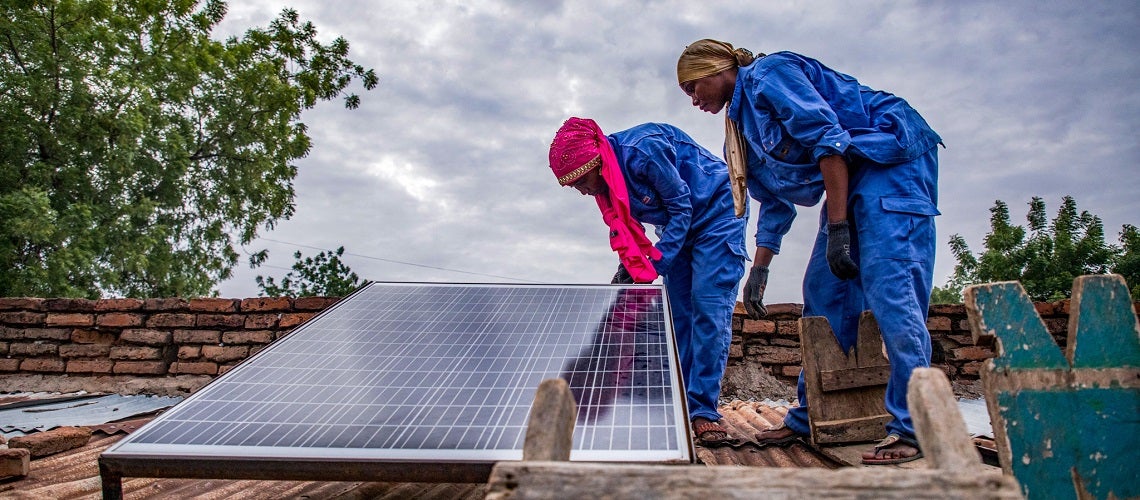 Women install solar panel on roof.
Women install solar panel on roof.
Delegates returned home from COP27 with long to-do lists and a formidable challenge: how to accelerate development that doesn’t rely on fossil fuels and creates more inclusive societies. Compounding this challenge are competing priorities in the pursuit of sustainable growth, such as energy efficiency, regeneration of natural systems, reduction in social inequalities, and women’s empowerment. Interventions that confront multiple challenges simultaneously are therefore in high demand. Green jobs for women could be such a solution, but there are several hurdles to overcome first.
Women are underrepresented in high potential climate-friendly sectors
Women continue to be underrepresented, underpaid, undervalued, and sometimes completely invisible in the labor market. Women’s labor force participation sits at just over 50%, far below that of men at 80%.The pandemic has widened this gap, and it will now take another 132 years to achieve gender equality. Sectoral and occupational inequities are also present – female enrollment in science, technology, engineering, and math (STEM) fields such as engineering is as low as 8%, and women are less likely than men to enter and more likely to leave the STEM workforce. Decision-making in companies, by senior managers and corporate executives, is still largely left to men. Women make up only 15% of board positions and 4% of CEOs globally.
It is unlikely that emerging climate-friendly sectors, such as low-carbon transport and green construction, will be a tabula rasa for women’s inclusion. Restrictive policies, discriminatory legal frameworks, unconscious biases, and unfavorable hiring practices in these professions reduce women’s meaningful participation. Green jobs, defined as decent jobs that contribute to environmental preservation or restoration, largely exclude women . For example, women make up only 32% of the renewable energy workforce and represent only 23% of managers in water utilities. These gaps precede the hiring stage, with only 62 women for every 100 men considered ‘green talent’.
At the same time, women are more concentrated in climate-vulnerable sectors. It is estimated that women make up 48% of the global agricultural workforce – up to 69% in South Asia – and dominate the global fish processing sector at 85%, although their contributions are often insecure and poorly remunerated. As the impacts of climate change worsen, the productive potential of these sectors will decline, putting downward pay pressure on women workers. Livelihood opportunities will also decline, along with the natural resources upon which local communities depend and global food security.
Investing in women would benefit businesses, climate action, and gender equality
There are opportunities to advance inclusive, green transitions while also achieving business gains – and compelling reasons to do so. Companies with a more gender-diverse workforce and leadership do better on risk management, innovation, and problem-solving – characteristics critical in combatting the climate crisis. Recent evidence suggests that female employees and leaders are more willing to act on climate and more effective when given the opportunity to do so . Following the Paris Agreement, companies with more gender diversity reduced their CO2 emissions by 5% more than those with more men in management, while firms with improvements in women’s share of board membership were more likely to reduce energy consumption, GHG emissions, and water use.
'Companies with a more gender-diverse workforce and leadership do better on risk management, innovation, and problem-solving – characteristics critical in combatting the climate crisis.'
Beyond this, labor supply and talent shortages are a major impediment to achieving national decarbonization roadmaps. Demand for green talent is currently outstripping supply, with green job postings growing 8% per year since 2015, compared to just 6% growth in green talent. Women with the credentials to work in STEM often have the skills to be more action-oriented and solution-driven when it comes to addressing climate change, but there are not enough of these women. Considering these dynamics, there is ample room to advance women’s representation in Paris alignment trajectories, while simultaneously addressing skill gaps.
Employing women can achieve several objectives simultaneously. In water utilities, greater gender diversity can help service providers improve customer satisfaction and community relations. In renewable energy, recruiting women can broaden the talent pipeline and address skill shortages, while also strengthening product and service design and delivery to women consumers, who are the key decision-makers for household energy choices. In the agriculture sector, closing gender gaps in access to productive resources could increase their farming yields by 20–30% – a key pillar of climate smart agriculture. Expanding women’s meaningful employment opportunities also increases their adaptive capacity, or their ability to respond effectively to environmental and climactic changes.
Upskilling and reskilling women can be a win-win solution
Tapping the talents of women seems like a solution with minimal tradeoffs – women can gain decent employment, with positive knock-on effects for communities; emissions can be reduced, while adaptive capacity is strengthened; businesses can achieve financial and competitive gains, while more effectively managing climate risks; and skills shortages can be addressed, while empowering disadvantaged groups. To realize these opportunities, investments in upskilling and reskilling women in green sectors and supporting the STEM school-to-work transition must be prioritized. At the same time, employers must reduce barriers by reexamining hiring and retention practices, offering inclusive childcare services, addressing unconscious biases, and preventing workplace sexual harassment.
'In the agriculture sector, closing gender gaps in access to productive resources could increase [women's] farming yields by 20–30% – a key pillar of climate smart agriculture.'
The World Bank Group is supporting this work and building the case for more gender inclusivity. For example, IFC’s Powered by Women initiative works with hydropower companies in Nepal to identify women’s employment gaps, reduce gender-based violence, and advance women’s position as employees and leaders. The World Bank’s RENEW MENA aims to increase women’s economic participation in clean energy jobs, create better workplace conditions, and combat widespread gender stereotypes about women in STEM. There are also efforts to increase baseline data on women’s representation in critical sectors, for example in energy storage, where IFC worked with the India Energy Storage Alliance to collect data on women’s participation. Equal Aqua (EA) creates benchmarks for women’s employment in the water sector and to date, has supported or informed the design of more than 40 World Bank operations.
An opportunity to rethink labor markets and deliver just, low-carbon transitions
The economic, social, and political restructuring required to avoid catastrophic climate impacts is a time-bound opportunity to rethink – fundamentally – how to structure labor markets in more inclusive ways. A key entry point is recognizing women’s existing contributions in climate-vulnerable sectors and creating space for them to play a major role in green and greening sectors. Investments in women’s skills development and supporting their green employment will prove critical to empower women and to deliver just, ambitious, and low-carbon transitions.



Join the Conversation